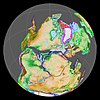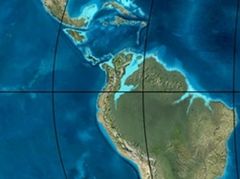|
Geological formation in the Colombian Andes
The Usme Formation (Spanish: Formación Usme, Tsu, Teu) is a geological formation of the Bogotá savanna, Altiplano Cundiboyacense, Eastern Ranges of the Colombian Andes. The formation consists of a lower part with predominantly shales with intercalated sandstone beds and an upper sequence with sandstones and conglomerates. The Usme Formation dates to the Neogene and Paleogene periods; Late Eocene to Early Oligocene epochs, and has a maximum thickness of 300 metres (980 ft).
Etymology
The formation was defined by Hubach in 1957 and named after the locality of Usme, Bogotá.[1]
Description
Lithologies
The Usme Formation is subdivided into a lower sequence of shales with intercalated sandstones and an upper part of sandstones and conglomerates.[1]
Stratigraphy and depositional environment
The Usme Formation unconformably overlies the Regadera Formation and is overlain by the Tilatá Formation.[2] The age has been estimated, based on palynological data, to be Late Eocene to Early Oligocene.[1] The depositional environment has been interpreted as marine with the upper part deposited in a deltaic setting.[3]
Outcrops
Type locality of the Usme Formation to the south of the Bogotá savanna The Usme Formation is found in its type locality in the synclinal of Usme, the valley of the Tunjuelo River.[1]
Regional correlations
Stratigraphy of the Llanos Basin and surrounding provinces
| Ma |
Age |
Paleomap |
Regional events |
Catatumbo |
Cordillera |
proximal Llanos |
distal Llanos |
Putumayo |
VSM |
Environments |
Maximum thickness |
Petroleum geology |
Notes
|
| 0.01 |
Holocene |
 |
Holocene volcanism
Seismic activity |
alluvium |
|
Overburden |
|
| 1 |
Pleistocene |
 |
Pleistocene volcanism
Andean orogeny 3
Glaciations |
Guayabo |
Soatá
Sabana |
Necesidad |
Guayabo |
Gigante
|
Alluvial to fluvial (Guayabo) |
550 m (1,800 ft)
(Guayabo) |
[4][5][6][7]
|
| 2.6 |
Pliocene |
 |
Pliocene volcanism
Andean orogeny 3
GABI |
Subachoque |
|
| 5.3 |
Messinian |
Andean orogeny 3
Foreland |
Marichuela |
Caimán |
Honda |
[6][8]
|
| 13.5 |
Langhian |
Regional flooding |
León |
hiatus |
Caja |
León |
Lacustrine (León) |
400 m (1,300 ft)
(León) |
Seal |
[7][9]
|
| 16.2 |
Burdigalian |
Miocene inundations
Andean orogeny 2 |
C1 |
Carbonera C1 |
Ospina |
Proximal fluvio-deltaic (C1) |
850 m (2,790 ft)
(Carbonera) |
Reservoir |
[8][7]
|
| 17.3 |
C2 |
Carbonera C2 |
Distal lacustrine-deltaic (C2) |
Seal |
|
| 19 |
C3 |
Carbonera C3 |
Proximal fluvio-deltaic (C3) |
Reservoir |
|
| 21 |
Early Miocene |
Pebas wetlands |
C4 |
Carbonera C4 |
Barzalosa |
Distal fluvio-deltaic (C4) |
Seal |
|
| 23 |
Late Oligocene |
 |
Andean orogeny 1
Foredeep |
C5 |
Carbonera C5 |
Orito |
Proximal fluvio-deltaic (C5) |
Reservoir |
[5][8]
|
| 25 |
C6 |
Carbonera C6 |
Distal fluvio-lacustrine (C6) |
Seal |
|
| 28 |
Early Oligocene |
C7 |
C7 |
|
Pepino |
Gualanday |
Proximal deltaic-marine (C7) |
Reservoir |
[5][8][10]
|
| 32 |
Oligo-Eocene |
C8 |
Usme |
C8 |
onlap |
Marine-deltaic (C8) |
Seal
Source |
[10]
|
| 35 |
Late Eocene |
 |
Mirador |
Mirador |
Coastal (Mirador) |
240 m (790 ft)
(Mirador) |
Reservoir |
[7][11]
|
| 40 |
Middle Eocene |
Regadera |
hiatus |
|
| 45 |
|
| 50 |
Early Eocene |
 |
Socha |
Los Cuervos |
Deltaic (Los Cuervos) |
260 m (850 ft)
(Los Cuervos) |
Seal
Source |
[7][11]
|
| 55 |
Late Paleocene |
PETM
2000 ppm CO2 |
Los Cuervos |
Bogotá |
Gualanday |
|
| 60 |
Early Paleocene |
SALMA |
Barco |
Guaduas |
Barco |
Rumiyaco |
Fluvial (Barco) |
225 m (738 ft)
(Barco) |
Reservoir |
[4][5][8][7][12]
|
| 65 |
Maastrichtian |
 |
KT extinction |
Catatumbo |
Guadalupe |
Monserrate |
Deltaic-fluvial (Guadalupe) |
750 m (2,460 ft)
(Guadalupe) |
Reservoir |
[4][7]
|
| 72 |
Campanian |
End of rifting |
Colón-Mito Juan |
[7][13]
|
| 83 |
Santonian |
Villeta/Güagüaquí |
|
| 86 |
Coniacian |
|
| 89 |
Turonian |
Cenomanian-Turonian anoxic event |
La Luna |
Chipaque |
Gachetá |
hiatus |
Restricted marine (all) |
500 m (1,600 ft)
(Gachetá) |
Source |
[4][7][14]
|
| 93 |
Cenomanian |
 |
Rift 2 |
|
| 100 |
Albian |
Une |
Une |
Caballos |
Deltaic (Une) |
500 m (1,600 ft)
(Une) |
Reservoir |
[8][14]
|
| 113 |
Aptian |
 |
Capacho |
Fómeque |
Motema |
Yaví |
Open marine (Fómeque) |
800 m (2,600 ft)
(Fómeque) |
Source (Fóm) |
[5][7][15]
|
| 125 |
Barremian |
High biodiversity |
Aguardiente |
Paja |
Shallow to open marine (Paja) |
940 m (3,080 ft)
(Paja) |
Reservoir |
[4]
|
| 129 |
Hauterivian |
 |
Rift 1 |
Tibú-
Mercedes |
Las Juntas |
hiatus |
Deltaic (Las Juntas) |
910 m (2,990 ft)
(Las Juntas) |
Reservoir (LJun) |
[4]
|
| 133 |
Valanginian |
Río Negro |
Cáqueza
Macanal
Rosablanca |
Restricted marine (Macanal) |
2,935 m (9,629 ft)
(Macanal) |
Source (Mac) |
[5][16]
|
| 140 |
Berriasian |
Girón |
|
| 145 |
Tithonian |
Break-up of Pangea |
Jordán |
Arcabuco |
Buenavista
|
Saldaña |
Alluvial, fluvial (Buenavista) |
110 m (360 ft)
(Buenavista) |
"Jurassic" |
[8][17]
|
| 150 |
Early-Mid Jurassic |
 |
Passive margin 2 |
La Quinta |
Noreán |
hiatus |
Coastal tuff (La Quinta) |
100 m (330 ft)
(La Quinta) |
[18]
|
| 201 |
Late Triassic |
 |
Mucuchachi |
Payandé |
|
[8]
|
| 235 |
Early Triassic |
 |
Pangea |
|
hiatus |
|
"Paleozoic" |
|
| 250 |
Permian |
 |
|
| 300 |
Late Carboniferous |
 |
Famatinian orogeny |
|
Cerro Neiva
() |
[19]
|
| 340 |
Early Carboniferous |
Fossil fish
Romer's gap |
Cuche
(355-385) |
Farallones
() |
|
Deltaic, estuarine (Cuche) |
900 m (3,000 ft)
(Cuche) |
|
| 360 |
Late Devonian |
 |
Passive margin 1 |
Río Cachirí
(360-419) |
|
|
Ambicá
() |
Alluvial-fluvial-reef (Farallones) |
2,400 m (7,900 ft)
(Farallones) |
[16][20][21][22][23]
|
| 390 |
Early Devonian |
 |
High biodiversity |
Floresta
(387-400)
|
|
|
|
Shallow marine (Floresta) |
600 m (2,000 ft)
(Floresta) |
|
| 410 |
Late Silurian |
Silurian mystery |
|
|
|
|
| 425 |
Early Silurian |
hiatus |
|
| 440 |
Late Ordovician |
 |
Rich fauna in Bolivia |
San Pedro
(450-490) |
|
Duda
() |
|
|
|
|
|
|
| 470 |
Early Ordovician |
First fossils |
Busbanzá
(>470±22)
|
Guape
() |
|
Río Nevado
() |
|
|
|
[24][25][26]
|
| 488 |
Late Cambrian |
 |
Regional intrusions |
Chicamocha
(490-515) |
Quetame
() |
Ariarí
() |
|
SJ del Guaviare
(490-590) |
San Isidro
() |
|
|
[27][28]
|
| 515 |
Early Cambrian |
Cambrian explosion |
|
|
[26][29]
|
| 542 |
Ediacaran |
 |
Break-up of Rodinia |
pre-Quetame |
post-Parguaza |
El Barro
() |
Yellow: allochthonous basement
(Chibcha Terrane)
Green: autochthonous basement
(Río Negro-Juruena Province) |
|
Basement |
[30][31]
|
| 600 |
Neoproterozoic |
|
Cariri Velhos orogeny |
Bucaramanga
(600-1400) |
pre-Guaviare |
[27]
|
| 800 |
 |
Snowball Earth |
[32]
|
| 1000 |
Mesoproterozoic |
 |
Sunsás orogeny |
Ariarí
(1000) |
La Urraca
(1030-1100) |
[33][34][35][36]
|
| 1300 |
Rondônia-Juruá orogeny |
pre-Ariarí |
Parguaza
(1300-1400) |
Garzón
(1180-1550) |
[37]
|
| 1400 |
 |
pre-Bucaramanga |
|
[38]
|
| 1600 |
Paleoproterozoic |
Maimachi
(1500-1700) |
pre-Garzón |
[39]
|
| 1800 |
 |
Tapajós orogeny |
Mitú
(1800) |
[37][39]
|
| 1950 |
Transamazonic orogeny |
pre-Mitú |
[37]
|
| 2200 |
Columbia |
|
| 2530 |
Archean |
 |
Carajas-Imataca orogeny |
[37]
|
| 3100 |
Kenorland |
|
| Sources
|
- Legend
- group
- important formation
- fossiliferous formation
- minor formation
- (age in Ma)
- proximal Llanos (Medina)[note 1]
- distal Llanos (Saltarin 1A well)[note 2]
See also
 Geology of the Eastern Hills Geology of the Eastern Hills Geology of the Ocetá Páramo Geology of the Ocetá Páramo Geology of the Altiplano Cundiboyacense Geology of the Altiplano Cundiboyacense
Notes and references
Notes
- ^ based on Duarte et al. (2019)[40], García González et al. (2009),[41] and geological report of Villavicencio[42]
- ^ based on Duarte et al. (2019)[40] and the hydrocarbon potential evaluation performed by the UIS and ANH in 2009[43]
References
- ^ a b c d Montoya & Reyes, 2005, p.65
- ^ Guerrero Uscátegui, 1992, p.6
- ^ Bayona et al., 2010, p.7
- ^ a b c d e f García González et al., 2009, p.27
- ^ a b c d e f García González et al., 2009, p.50
- ^ a b García González et al., 2009, p.85
- ^ a b c d e f g h i j Barrero et al., 2007, p.60
- ^ a b c d e f g h Barrero et al., 2007, p.58
- ^ Plancha 111, 2001, p.29
- ^ a b Plancha 177, 2015, p.39
- ^ a b Plancha 111, 2001, p.26
- ^ Plancha 111, 2001, p.24
- ^ Plancha 111, 2001, p.23
- ^ a b Pulido & Gómez, 2001, p.32
- ^ Pulido & Gómez, 2001, p.30
- ^ a b Pulido & Gómez, 2001, pp.21-26
- ^ Pulido & Gómez, 2001, p.28
- ^ Correa Martínez et al., 2019, p.49
- ^ Plancha 303, 2002, p.27
- ^ Terraza et al., 2008, p.22
- ^ Plancha 229, 2015, pp.46-55
- ^ Plancha 303, 2002, p.26
- ^ Moreno Sánchez et al., 2009, p.53
- ^ Mantilla Figueroa et al., 2015, p.43
- ^ Manosalva Sánchez et al., 2017, p.84
- ^ a b Plancha 303, 2002, p.24
- ^ a b Mantilla Figueroa et al., 2015, p.42
- ^ Arango Mejía et al., 2012, p.25
- ^ Plancha 350, 2011, p.49
- ^ Pulido & Gómez, 2001, pp.17-21
- ^ Plancha 111, 2001, p.13
- ^ Plancha 303, 2002, p.23
- ^ Plancha 348, 2015, p.38
- ^ Planchas 367-414, 2003, p.35
- ^ Toro Toro et al., 2014, p.22
- ^ Plancha 303, 2002, p.21
- ^ a b c d Bonilla et al., 2016, p.19
- ^ Gómez Tapias et al., 2015, p.209
- ^ a b Bonilla et al., 2016, p.22
- ^ a b Duarte et al., 2019
- ^ García González et al., 2009
- ^ Pulido & Gómez, 2001
- ^ García González et al., 2009, p.60
Bibliography
- Bayona, Germán; Montenegro, Omar; Cardona, Agustín; Jaramillo, Carlos; Lamus, Felipe; Morón, Sara; Quiroz, Luiz; Ruíz, María C.; Valencia and Mauricio Parra, Victor (2010), "Estratigrafía, procedencia, subsidencia y exhumación de las unidades paleógenas en el Sinclinal de Usme, sur de la zona axial de la Cordillera Oriental - Stratigraphy, provenance, subsidence and exhumation of the Paleogene succession in the Usme Syncline, southern axial zone of the Eastern Cordillera" (PDF), Geología Colombiana, 35: 5–35, retrieved 2017-03-16
- Guerrero Uscátegui, Alberto Lobo (1992), Geología e Hidrogeología de Santafé de Bogotá y su Sabana, Sociedad Colombiana de Ingenieros, pp. 1–20
- Montoya Arenas, Diana María; Reyes Torres, Germán Alfonso (2005), Geología de la Sabana de Bogotá, INGEOMINAS, pp. 1–104
Maps
External links
|


























